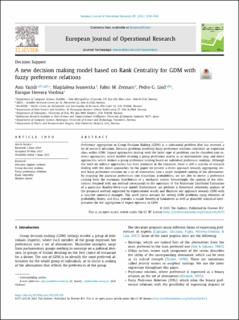| dc.contributor.author | Yazidi, Anis | |
| dc.contributor.author | Ivanovska, Magdalena | |
| dc.contributor.author | Zennaro, Fabio Massimo | |
| dc.contributor.author | Lind, Pedro | |
| dc.contributor.author | Viedma, Enrique Herrera | |
| dc.date.accessioned | 2022-01-31T10:26:00Z | |
| dc.date.available | 2022-01-31T10:26:00Z | |
| dc.date.created | 2021-06-14T12:14:29Z | |
| dc.date.issued | 2021 | |
| dc.identifier.citation | European Journal of Operational Research. 2021, . | en_US |
| dc.identifier.issn | 0377-2217 | |
| dc.identifier.uri | https://hdl.handle.net/11250/2975917 | |
| dc.description.abstract | Preference aggregation in Group Decision Making (GDM) is a substantial problem that has received a lot of research attention. Decision problems involving fuzzy preference relations constitute an important class within GDM. Legacy approaches dealing with the latter type of problems can be classified into indirect approaches, which involve deriving a group preference matrix as an intermediate step, and direct approaches, which deduce a group preference ranking based on individual preference rankings. Although the work on indirect approaches has been extensive in the literature, there is still a scarcity of research dealing with the direct approaches. In this paper we present a direct approach towards aggregating several fuzzy preference relations on a set of alternatives into a single weighted ranking of the alternatives. By mapping the pairwise preferences into transitions probabilities, we are able to derive a preference ranking from the stationary distribution of a stochastic matrix. Interestingly, the ranking of the alternatives obtained with our method corresponds to the optimizer of the Maximum Likelihood Estimation of a particular Bradley-Terry-Luce model. Furthermore, we perform a theoretical sensitivity analysis of the proposed method supported by experimental results and illustrate our approach towards GDM with a concrete numerical example. This work opens avenues for solving GDM problems using elements of probability theory, and thus, provides a sound theoretical fundament as well as plausible statistical interpretation for the aggregation of expert opinions in GDM. | en_US |
| dc.language.iso | eng | en_US |
| dc.publisher | Elsevier | en_US |
| dc.rights | Navngivelse 4.0 Internasjonal | * |
| dc.rights.uri | http://creativecommons.org/licenses/by/4.0/deed.no | * |
| dc.title | A new decision making model based on Rank Centrality for GDM with fuzzy preference relations | en_US |
| dc.type | Peer reviewed | en_US |
| dc.type | Journal article | en_US |
| dc.description.version | publishedVersion | en_US |
| dc.source.pagenumber | 12 | en_US |
| dc.source.journal | European Journal of Operational Research | en_US |
| dc.identifier.doi | 10.1016/j.ejor.2021.05.030 | |
| dc.identifier.cristin | 1915560 | |
| cristin.ispublished | true | |
| cristin.fulltext | original | |
| cristin.qualitycode | 2 | |

